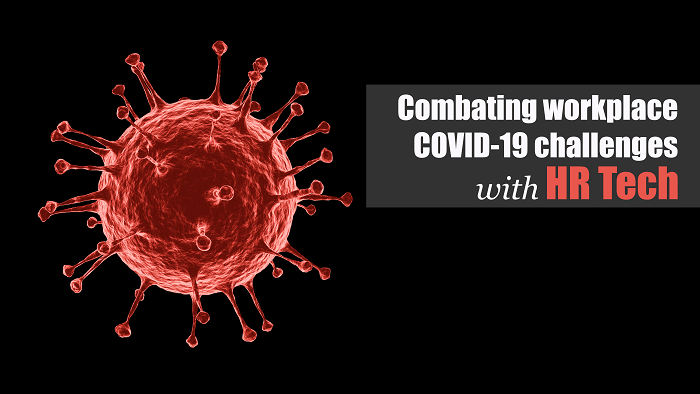Many employees re-entering the workplace in this COVID-19 environment are encountering an onslaught of new and creative HR strategies and technologies that may make them feel safer at work than at home.
The solutions run the gamut and address the many aspects of physical interaction that have been impacted by the virus.
 For instance, RightCrowd Software uses Bluetooth technology and digital ID badges to continuously monitor social distancing. If employees stand too close together for a period of time, an LED light first flashes yellow and then red and also records the encounter by capturing the badge number, versus the employee’s name, which enables rapid contact tracing.
For instance, RightCrowd Software uses Bluetooth technology and digital ID badges to continuously monitor social distancing. If employees stand too close together for a period of time, an LED light first flashes yellow and then red and also records the encounter by capturing the badge number, versus the employee’s name, which enables rapid contact tracing.
Binah.ai developed an app that captures vital signs through video of a person’s face. Any organization can now use Skedulo’s high capacity-based scheduling technology, which was initially developed for healthcare organizations conducting COVID-19 testing. Hacka Labs reinvented the door handle by embedding a laser that self-sterilizes to minimize virus transmission throughout buildings. Eight back-to-work kits are also being offered by iPromo, which include a keychain attachment tool that eliminates the need to touch ATM buttons, door handles or grocery self-checkout screens.
And that’s just the beginning.
Preparation Leads to Comfort
Besides virus-proofing the office, HR professionals are also concerned with the emotional
consequences of returning employees to a transformed environment. Some may be disoriented about the redesigned physical space, and many may feel anxious about new policies and procedures. Others may be afraid of catching the virus from co-workers and spreading it to family members. Worse yet, some may have feelings they don’t understand or simply can’t explain.
Related: COVID-19 strategy 101–how to improve mental health
To help ease employee concerns, Traliant developed a customizable, 25-minute training video in May that addresses the psychological impacts of the pandemic.
“Everything else deals with how to wash your hands or wear a mask, which is great, but you need to [address] the changes they may experience to prepare them emotionally,” says Andrew Rawson, co-founder and chief learning officer at Traliant, which offers regulatory, online compliance training.
For instance, he says, a popular conference room may now be off limits because it’s too small for social distancing. Doors may be removed to avoid the need to touch handles. The cafeteria may no longer offer a salad bar. Employees may even be asked to follow traffic arrows to avoid bumping into or crossing each other.
He says the video offers three takeaways: a powerful subtext message that the organization cares about employees’ wellbeing; the importance of being flexible, since conditions are apt to change on a daily or weekly basis; and that managers need be highly sensitive to changes in employee behavior.
Companies are asking employees to watch the video before returning to the workplace. Rawson says this gives them time to digest the changes and understand what to expect, which can reduce their anxiety, fear or even shock.
Employees even learn how to address a co-worker who isn’t following the rules, giving them “emotional permission” to speak up, Rawson says, adding the video also informs HR about state-based employee training requirements regarding COVID-19.
“The more prepared [employees] are for changes they may experience, the more comfortable they’ll be with those changes,” he says.
Practical and Creative
Innovative Office Solutions recently published Return to the Workplace Guide. This free, online resource offers a variety of solutions like defining low- or high-touch workplace traffic zones, installing touch-free water faucets or using an automated people counter to help manage the traffic and number of occupants in a space.
“It breaks everything down into touch levels and traffic levels,” says Christine DeGrammont, director of training and development at Innovative Office Solutions, which designs spaces and offers product and technical solutions. “This really takes the mystery out of how a company gets started [bringing employees] back to the office. They’ll think maybe this isn’t as overwhelming as they thought.”
She believes HR’s biggest challenge is navigating through all the unknowns of the pandemic, which includes employee reaction. Several weeks after people return to the workplace, create a focus group that’s representative of your workforce, says DeGrammont. Ask members, “Now that you’ve had time to adjust to these changes, what works, what doesn’t, what else do you need to feel safe and be productive?”
She also formed a customer focus group of law firms, big and small, to share best practices. One member reported removing many chairs from its conference rooms. But since it didn’t have a storage room to keep them in, it strategically positioned the excess chairs around the office with key signage, reminding employees to wear a mask, for example, or identifying spaces where they could work.
Meanwhile, DeGrammont has also conducted several, online wellness workshops for the company’s estimated 250 employees that focus on their emotional and physical wellbeing and solicited feedback on how the company can continue to support them.
“There are many creative options out there,” she says. “One of the best approaches with change management is asking employees what they want. It makes them feel safe, heard and free to do their job.”

